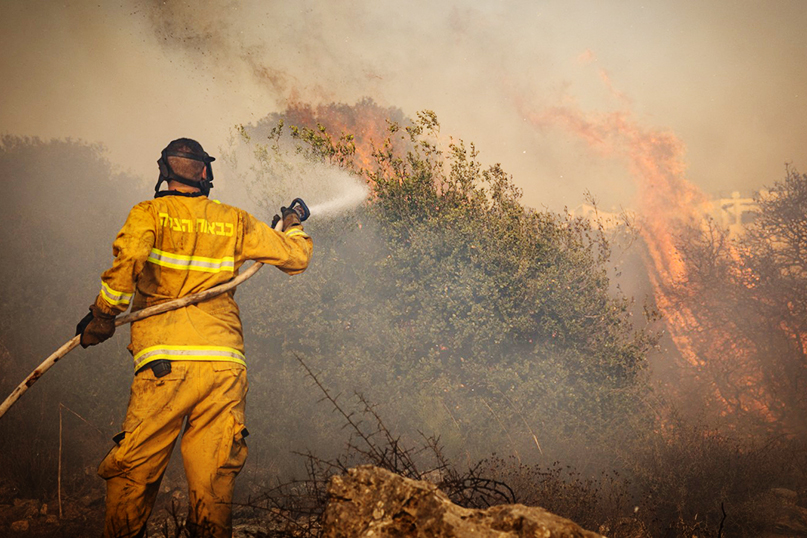
By Abigail Klein Leichman
(Israel21C via JNS) As the Ledger went to press, the state of California had more than 500 blazes burning, many of them mega-fires. and forest fires have been reported in 14 other U.S. states. In addition, this year alone, Australia battled its largest-ever bushfire and, in August, Argentina registered 8,493 fire alerts and Cyprus wasn’t far behind.
The frequency and intensity of wildfires are growing across the globe. Reasons include hotter and drier weather, poor land use management and human negligence.
Israel’s worst fire was in December 2010 in the Carmel Forest when 44 people died in the blaze. It was a wakeup call for the state, forcing authorities to rethink strategies and bring the dangers of wildfire to everyone’s attention. It even motivated employees at the nearby Google office in Haifa to build the company’s first crisis alert product.
Since 2018, the country’s professional and volunteer firefighters and foresters have not only had to tackle regular forest fires, but also had their hands full with daily terrorist arson attacks launched from Gaza on southern Israel.
In August alone, more than 450 such fires burned almost 495 acres of Western Negev forest, not counting agricultural fields. Over the last couple of years, thousands of acres of Israeli parks, fields, and forests have been reduced to ash.
“The difference between Israel and other places is the size of the country, the density of the population and long periods of dry windy weather,” says Professor Avi Perevolotsky, former chief scientist at the Israel Nature and Parks Authority (INPA) and a retired Volcani Research Center specialist in natural resources management.
“We don’t have large areas like in Australia that can burn for days without damaging population centers.”
With such an obvious and dangerous growing problem, it’s no surprise that Israeli thinkers, innovators and aid experts are devoting a great deal of time and energy in the hunt for solutions that will do anything from prevention and early warning to fighting the fires itself. It’s also no surprise that these solutions are now attracting the attention of people all over the world.
“We try to think out of the box,” says Shay Levy, head of the National Fire and Rescue Authority’s Wildfire Doctrine Department and a renowned lecturer on forest fires.
Animals can help thwart fires
In addition to fire-prevention maintenance such as pruning lower branches to disconnect them from ground level, Israel uses grazing herds of goats, cows and sheep to create protective firebreaks around woodland areas.
California, which until the 1980s used buffalo to do the same, is learning from Israel how to reintroduce this natural practice, says Levy.
Since January, more than 50,000 sheep have been moved to the forests in the Gaza “envelope” border area, says Danny Ben-David, head of Keren Kayemeth LeIsrael-Jewish National Fund (KKL-JNF) Southern District firefighters.
Planting forests that prevent and survive flames
Forests planted by KKL-JNF cover 10 percent of Israel or 250,000 acres. They include millions of Jerusalem pine trees. In the past, fire-damaged pines were immediately removed, and new ones planted the first winter after the fire.
However, foresters learned that pines regenerate naturally and even proliferate after they’re burned. They’re highly flammable and must be thinned to prevent adding fuel to forest fires.
Today it is understood that broadleaved trees (hardwoods) are a natural firebreak. Around 2006, KKL-JNF began switching from pine plantings to less-flammable cedars, oaks, terebinths, arbutus and carob, as well as fig, pomegranate and mulberry.
Ben-David tells ISRAEL21c that in the Gaza envelope “we have already prepared 300 dunams [74 acres] to plant next year with broadleaved trees in the winter, such as sycamore and eucalyptus, because they can survive fires and regrow afterward. You don’t want to cut all the trees right after they’re burned. We wait at least one year later to see which trees can survive and regenerate.”
Phones give early warning
Humidity data collected over four years by OpenSignal’s WeatherSignal Weather app—using sensors in 40,000 smartphones worldwide—gave Tel Aviv University environmental studies Ph.D. student Hofit Shachaf a unique way to identify and warn authorities about conditions that promote forest fires.
Low humidity makes plants and trees more susceptible to fires, and the likelihood of a fire increases.
“If we see unusual data [from phone sensors] and all variables indicate a high risk of fires, we can treat it as a warning sign and give immediate warning to the security and rescue forces,” says Shachaf.
“When every mobile device is used as a portable weather station, the coverage is much wider than that of the meteorological stations.”
Drones find fire hotspots
Eliran Oren hadn’t yet graduated from Lev Academic Center-Jerusalem College of Technology before co-founding FlyTech IL in late 2016. The company trains drone pilots, provides professional aerial photography and sells related technology.
FlyTech IL’s work with six government agencies includes a contract with INPA to train and manage aerial park ranger units that use its drones to survey areas of the Golan, Carmel and Gaza border for signs of fire.
“We have special thermal imaging techniques to help them find hotspots that are just starting,” Oren tells ISRAEL21c. “They can assess and investigate hotspots and sometimes lead firefighters to the fire.”
Streaming live video of active fires
To help emergency responders get where they’re needed faster and more accurately, Edgybees uses unmanned aircraft to stream live video from active fire areas and adds real-time augmented reality data.
“We send that information back to the command centers and allow the people on the ground to plan escape routes for evacuees and where to put first responders,” says CEO Adam Kaplan.
“We use data to allow people to understand what they are looking at in real time and make instant decisions.”
Edgybees, based in Maryland and in Herzliya, started as a gaming company for drone hobbyists. It has been deployed in fires situations in Australia and California.
High-precision firefighting from the air
Hydrop, a new high-altitude, high-precision firefighting solution developed by Israeli defense contractor Elbit Systems, enables firefighting from the air even during nighttime or in poor visibility conditions.
The aircraft flies at 500 feet, four times higher than the average altitude of firefighting sorties. It rains down liquid pellets—produced onboard at the rate of 10 tons per hour—in a computed ballistic trajectory to achieve a precise hit with the saturation of one to two liters per square meter.
The pellets can be filled with water, foam or fire retardant. They are biodegradable and leave no harmful residues.
Fighting treetop fire
Fighting Treetop Fire is developing a system of algorithm-controlled laser beams that zap combustible foliage, controlled from a safe distance via helicopter or truck.
Electro-optics physicist Daniel Leigh founded the company in 2012 and brought aboard experts including Zvika Avni, former chief of the KKL-JNF Forestry Department.
Removing leaves, thin branches and pine needles off treetops in the path of fire forces flames downward, where they can more easily be controlled by conventional methods, Leigh explains.
“We have patents in the United States and other countries,” he tells ISRAEL21c. “We are now seeking investments or strategic partnerships to build a prototype for field use.”
Cooperation abroad
Earlier this week, a 10-man delegation from Israel’s Fire and Rescue Authority took off for California to help firefighting efforts for the next two weeks.
Last year, Israelis flew to assist Brazilian firefighters combatting blazes in the Amazon rainforest and Ethiopian firefighters faced with a complex fire in Simien Mountains National Park.
In Israel, firefighting has increasingly become a joint project across countries.
Sharing equipment, manpower, expertise, and new ideas improves each country’s ability to prevent and extinguish fires and rehabilitate burned forests wisely.
Helping blaze victims
Forest fires take an immense toll on residents and aid workers alike. Israeli aid agencies and companies regularly step forward to offer everything from basic supplies to water generators to trauma counseling.
In November 2018, Camp Fire devastated the northern California town of Paradise. In addition to the 86 people killed and 15 injured, the blaze destroyed 18,804 structures and left many residents bereaved of their homes, friends, relatives, pets and treasured possessions.
The US affiliate of Israeli humanitarian aid organization IsraAID organized a response that included sending two Israeli psychosocial support specialists to work with kids whose families were dislocated due to the fire. IsraAID experts also workshops and trainings for hospital workers, teachers and community leaders.
Last January, nine Israeli and two Australian SmartAID volunteers were among the first to enter Australia’s Kangaroo Island to help locals affected by wildfires.
The SmartAID team worked alongside the Australian army, firefighters and local nonprofit partner BlazeAid to clear the rubble of burned homes, help open access routes and assist farmers in rebuilding their livelihood.
Pinpointing poor air quality
The current combination of COVID-19 and widespread wildfires present serious respiratory risks as toxic smoke exposure extends far beyond areas of fire.
This is why clients in many countries are turning to live air-quality reports provided by Israeli company BreezoMeter.
Rather than relying on sensor information satellite imagery—both of which can become unavailable during a wildfire—BreezoMeter factors information from numerous data sources such as real-time traffic satellites, active fires and meteorological input.
BreezoMeter offers a fire-specific application programming interface (API) that clients can build into software that alerts to active fires in local areas. There are also BreezoMeter APIs specific to air pollution, pollen and environmental intelligence.
This live footage highlights how BreezoMeter’s model captured the rapidly spreading smoke across California state lines on Aug. 20-22, 2020.
Is it safe to go out?
Israeli weather intelligence platform ClimaCell won the “StandWithAus” hackathon held in Tel Aviv at the beginning of the year in response to the Australian bush fires.
The ClimaCell team devised AirKoalaty, an application now operating in Australia, to help people make an informed choice about when the air outside is safe for specific activities such as jogging, tennis, camping and going to the beach.
ClimaCell’s H.O.O.P. (Health Operations Optimization Platform) combines air quality insights with essential hyper-local weather data, allowing businesses to prioritize and plan their operations around health risks.
Drinking water from the air
In partnership with the American Red Cross, the U.S. affiliate of Israeli company Watergen sent a GEN-350 atmospheric water generator on a specially outfitted truck to provide safe drinking water to aid workers in Paradise.
Watergen USA President Yehuda Kaploun said the units could even help prevent forest fires if they are placed strategically by power lines and continuously create water.
Letting the forest rehabilitate alone
An important lesson learned in Israel over the past decade is to let burned forests rehabilitate naturally, under close observation.
“The soil is very apt to erosion after a fire, so we don’t even work in the burned area,” KKL-JNF Jerusalem region forest supervisor Chanoch Zoref explained to ISRAEL21c after some 4,000 brush and urban fires devastated several regions of Israel in November 2016 in central Israel.
“After the first winter, the area will be more secure in terms of soil erosion. A year later, we’ll check the environment and cut dead pines that might be a hazard to hikers or roads or to the rehabilitation of the environment,” said Zoref.
“During the next three years, we’ll undertake a planning process to decide what goals we want to achieve here. In the majority of areas, we will let the natural process take its course for about 10 years, and then we’ll make a survey of the situation.”
This article first appeared in ISRAEL21c.
Main Photo: Firefighters extinguishing a forest fire near Jerusalem in November 2019. (Credit: Noam Revkin Fenton/Flash90.








 Southern New England Jewish Ledger
Southern New England Jewish Ledger













